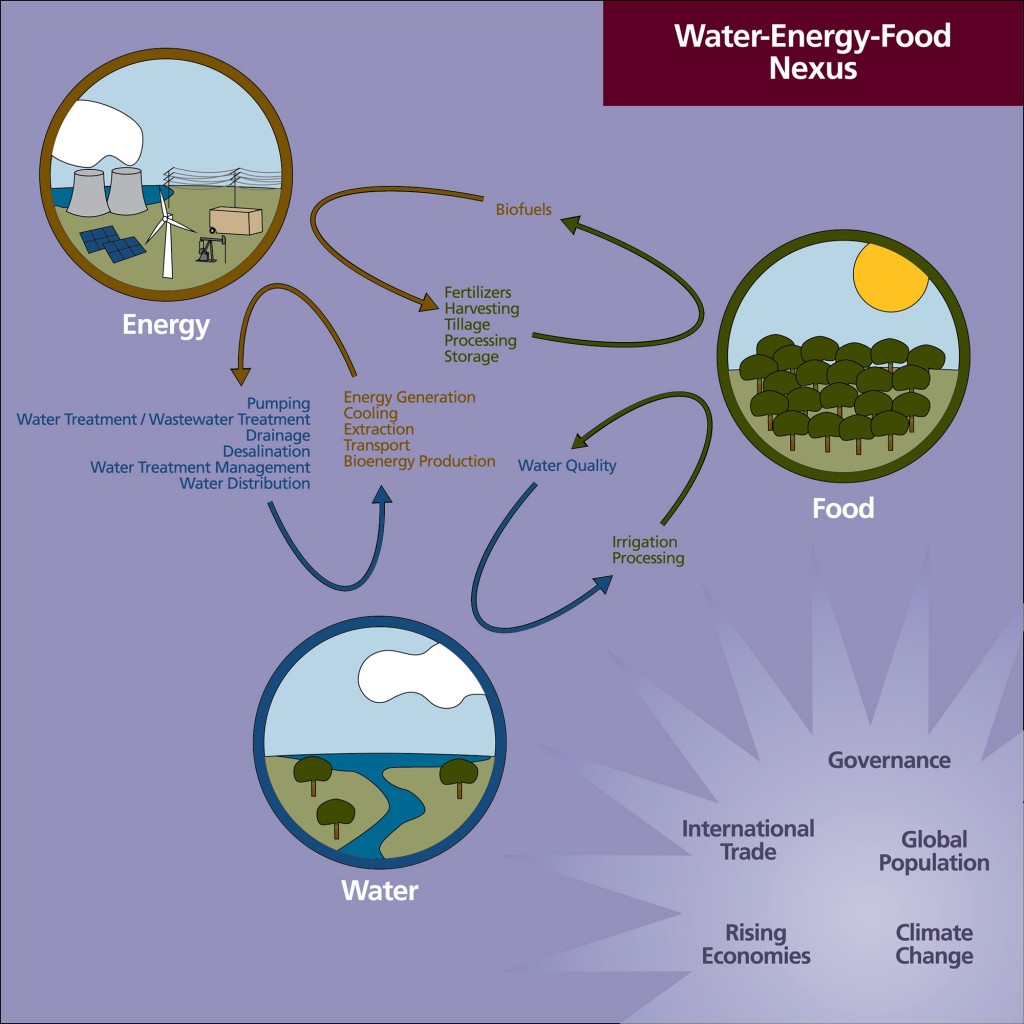The availability of water and access to water has dictated civilizations’ choices throughout human history. Historically, primary sources of water came through rainfall and surface water; while in the modern era, technology has provided opportunities to exploit underground water sources for use in irrigation, consumption, and industry. The availability of water dictates the viability of food resources and supports food production on large scales. In addition to food, water is intricately intertwined with the production, transportation, and use of most forms of energy, including shale oil and gas.
Looking to the future, climate change will impact water resources through anticipated shifts in the patterns of rainfall and water availability. Such a change has the potential to significantly impact competition for water, particularly in the Southwest United States.
The Water-Energy-Food Nexus
To better manage our resources, we must gain a more complete understanding of the interdependence between water, energy, and food. Known as water-energy-food (WEF) nexus, a mastery of the relationships between these resources has the potential to strategically inform policy and planning, protect regions from vulnerability, and provide solutions for problems that currently exist or may arise.
The WEF nexus is complex, and there are many variables that are difficult to predict. Existing studies have looked at the role and impact of the WEF nexus on the development of energy, land use, urban growth, and water policies, but few explore the trade-offs and synergies at regional or national levels, and there has been little consideration for the nexus and the impact of climate variability on water supplies.
Dr. Rabi H. Mohtar, a TEES Endowed Professor in the Departments of Biological & Agricultural Engineering and Civil Engineering, along with Dr. Bruce A. McCarl, a Distinguished Professor of Agricultural Economics, will address these challenges in a new case study in the San Antonio, Texas region. Focusing on understanding the WEF nexus in the context of population growth, climate change, and developing scientific breakthroughs, the pair will address the interrelations of water, food, and energy, and the potential benefits for regional planning and coordination.

Selecting the Region
Mohtar and McCarl selected the San Antonio region based on the following:
- Increased use of hydraulic fracturing for regional shale oil and gas plays
- Rapid population growth
- Active irrigated food production sector
- Important regional environmental issues, including the emerging water deficit
These four factors highlight the impact that water, energy, and food will have on this area in the future and emphasize the need for the development of a regional WEF plan. Increases in usage of one resource often also affect another resource’s availability, leading to compounding challenges. The San Antonio region provides a comprehensive set of these compounding challenges and will add depth to Mohtar and McCarl’s analysis.
San Antonio Regional Compounding Challenges
Challenge: Using More Water Requires More Energy
Oil and gas production from hydraulic fracturing in Texas requires between 10,000 to 30,000 cubic meters of water per well. This process generates large amounts of contaminated water after injection, and challenging decisions must be made about its disposal, treatment, and reuse. Through the entire process, from water collection, transportation to the site, injection, recovery, and treatment and disposal, energy is consumed.
Challenge: Using Water Faster than Aquifer Recharge
The Eagle Ford Shale, just south of Bexar County in the San Antonio region, has substantial hydraulic fracturing activity. This area has seen an increase in activity over the last few years and that is expected to continue into the future. Not only does hydraulic fracturing require large amounts of water, but research has also shown that groundwater consumption for oil and gas production can be 2.5 times greater than the rate of recharge in the aquifers. Over time, this demand for water could lead to a decline in the quantity of water available for other uses.
Challenge: Using More Energy to Retrieve More Water
A 40% deficit in water is projected for the San Antonio Region, without considering the usage for hydraulic fracturing. The city of San Antonio aims to reduce its reliance on the Edwards Aquifer and diversify its water portfolio to meet demands of growing agricultural, industrial, municipal, ecological, and recreational uses. In the next 25 years, the city expects to launch brackish ground water desalinization, pump additional water from the Edwards Aquifer, and transport Carrizo Aquifer groundwater into San Antonio. Energy intensive water plans, such as desalinization, will further increase the demand for energy, making critical a clear understanding of the best energy-water portfolio options for the intended development.
San Antonio Regional Opportunities
Opportunities do exist in the region for synergistic cooperation – even among diminishing resources.
Opportunity: Geothermal Energy Generation
In many areas in Texas, unique geothermal resources exist in large, exploitable shale formations. More than 12 billion barrels of water are produced each year from crude oil and natural gas wells. This water, often extracted from the ground at relatively high temperatures, could be used to generate electricity. Additionally, the water, if treated, could be reused for agriculture, municipal and industrial purposes.
The Case Study
Mohtar and McCarl will work with the Texas Water Development Board, municipal utilities, agricultural data sources, counties, organizations, and corporations to collect data and build a database for water, energy, population, industrial growth, and food systems in the San Antonio area. Combining McCarl’s resources on economic forecasts and climate change trends and with population growth information, this data will be used to generate the initial analysis protocol for the tradeoffs between the proposed future scenarios. Using Mohtar’s existing Water-Energy-Food Nexus online platform at www.wefnexustool.org and existing work in the South Central Texas region, Mohtar and McCarl will develop a more comprehensive tool for scenario development and trade-off analysis.
Looking to the Future
In the future, Mohtar and McCarl hope to assemble a team that will apply this research to regions across the world. Considering alternative scenarios of water supply, development in the energy industry, regional growth, and climate change, the larger team will offer case study results and provide data for other WEF hotspot regions in the U.S. and internationally.


